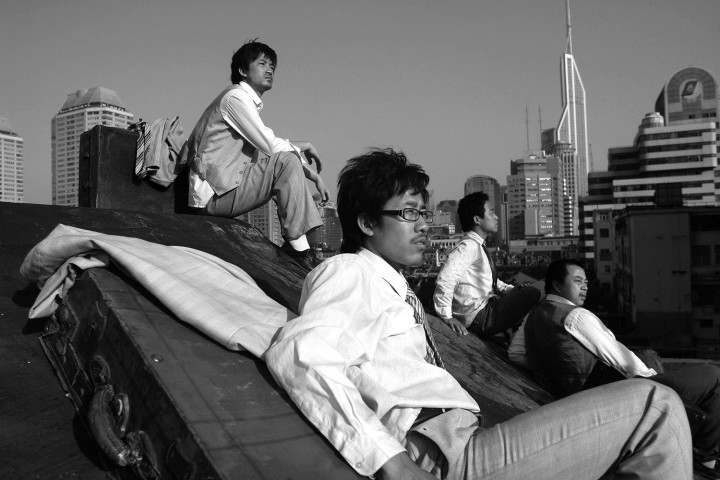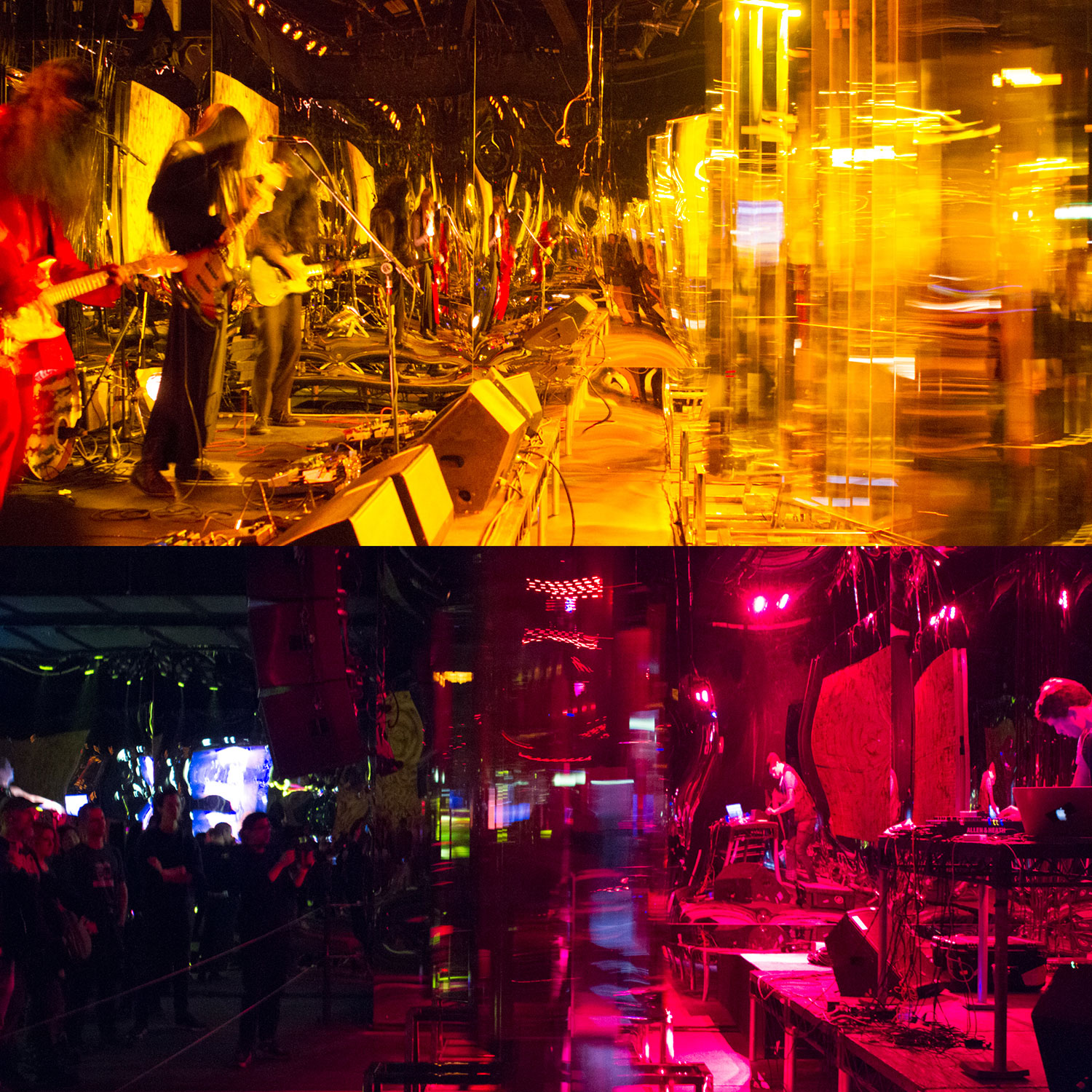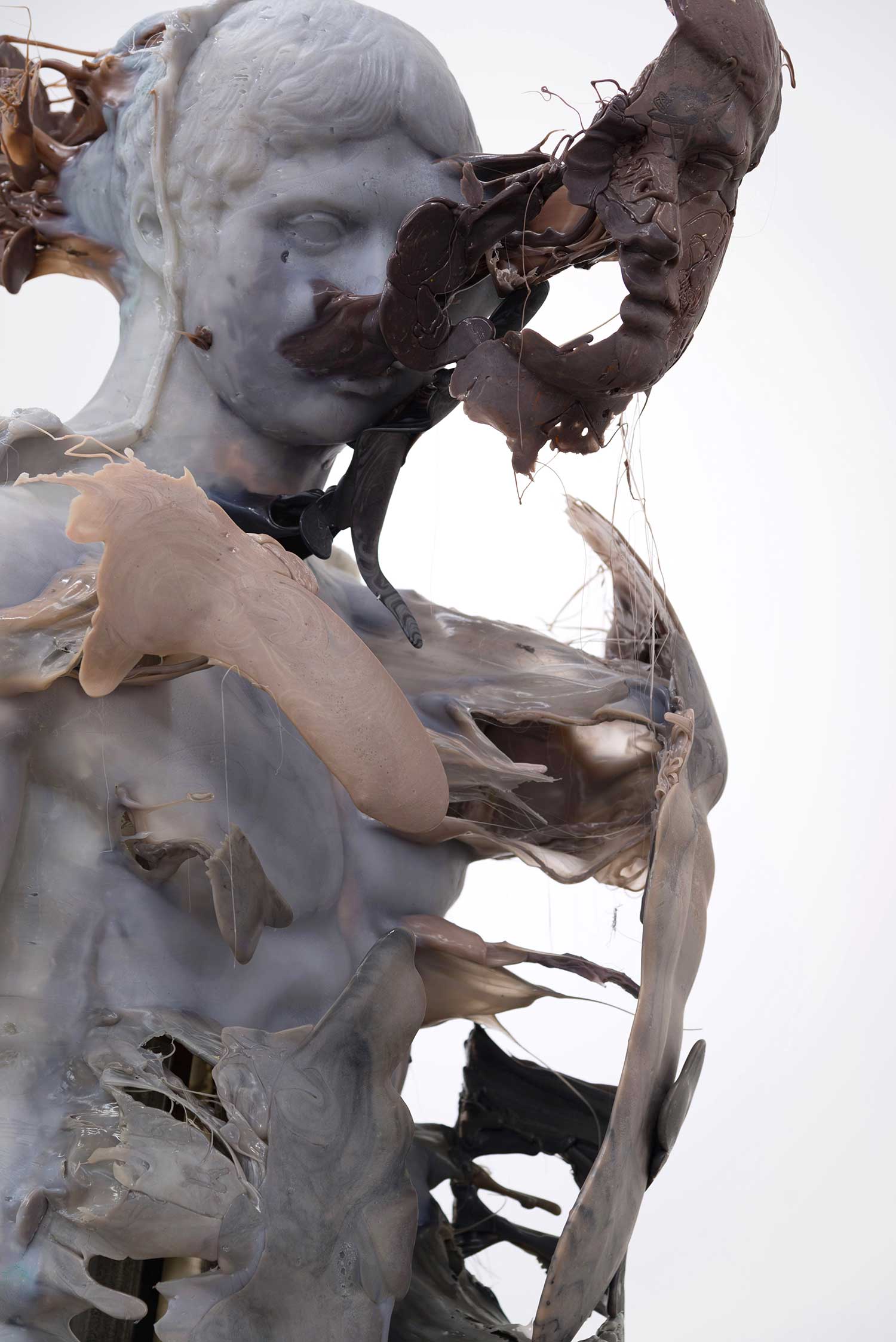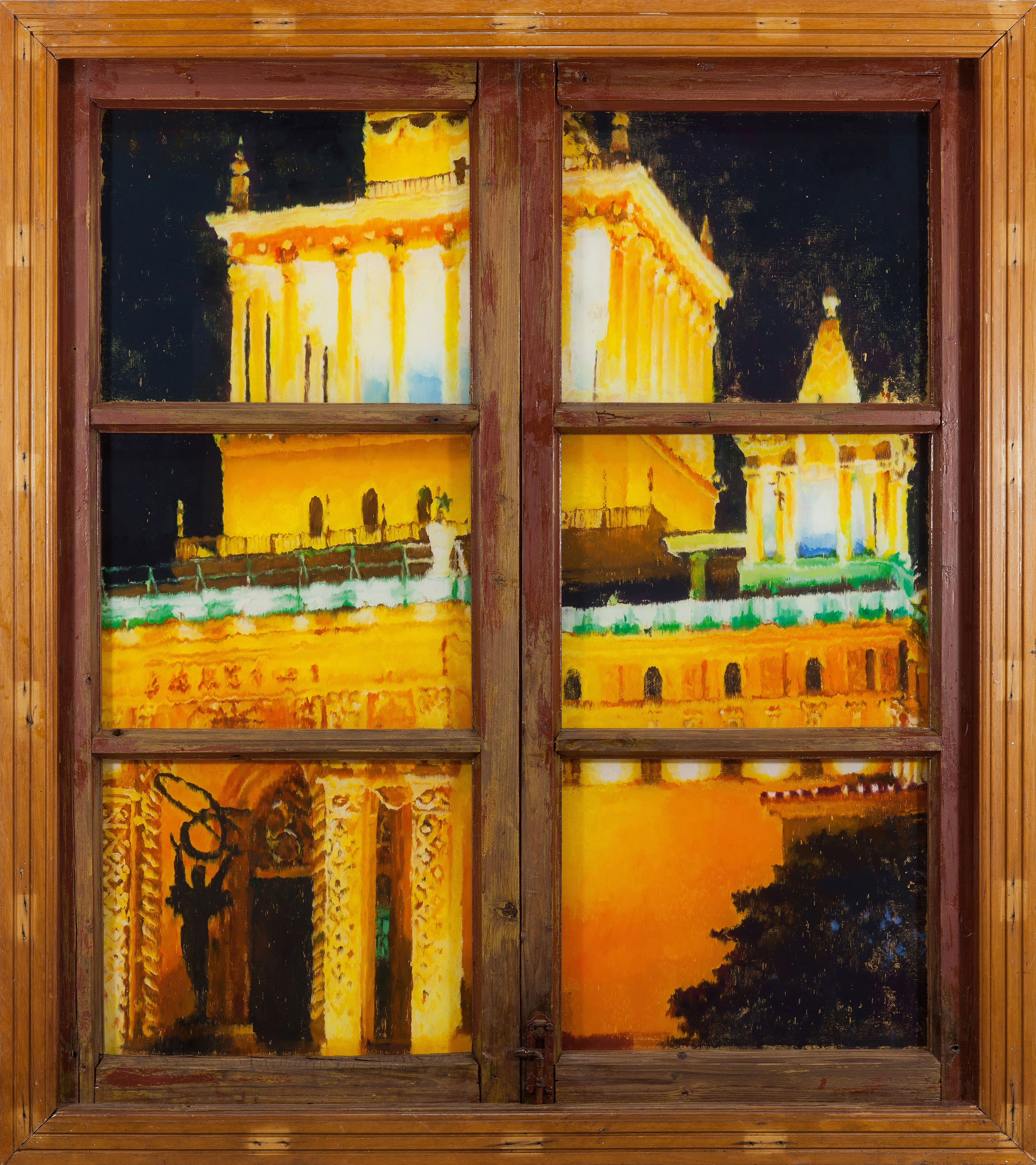In recent years, Shanghai, China’s financial and economic heart, has successfully challenged Beijing as the sole center of contemporary art by building new and improved infrastructures, of which museums comprise a large part. Much has been written about Shanghai’s “museum boom,” which started around 2012, but few are informed about the city’s extant museum culture since the early 2000s. It is no exaggeration to say that this scene has witnessed enormous ups and downs both locally and nationally. This timeline traces the historical trajectory of the contemporary art museum in one of the most up-and-coming art capitals of the world.
2003
The Shanghai Art Museum hosts the 3rd Shanghai Biennale. Video art and installation make their first appearances in an official art event. For the first time the Biennale is open to international artists and curators, thus beginning its transformation from a municipal cultural event to one of the most important, globally recognized platforms for contemporary Chinese art.
2003
The Shanghai Duolun Museum of Modern Art opens its doors. Situated in the cultural and historical Duolun Road area and initiated partially by the government (Hongkou District), the museum is the first of its kind in the city. The inaugural exhibition, titled “Open Sky,” features the most sought-after contemporary Chinese artists of the day.
2005
September
Shanghai’s Museum of Contemporary Art (MoCA Shanghai) is founded. Centrally located in People’s Park on West Nanjing Road, MoCA Shanghai is a private museum with an exhibition space of two floors totaling four thousand square meters. The museum’s mission is to promote contemporary art and design and to cultivate their appreciation by the general public. Its opening show is a retrospective of the French artist duo Pierre et Gilles.
Established by the Shanghai Zendai Group, the Zendai Museum of Modern Art (Zendai MoMA) officially opens to the public in Pudong Thumb Plaza. With an exhibition space of more than 1500 square meters, its goal is not only to exhibit original art works but also to encourage academic debate, revisiting the traditional definitions of what an art museum is supposed to represent.
2006
June
MoCA Shanghai presents “Italy Made in Art: Now – Contemporary Arts & Industrial Design” as part of the “Year of Italian Culture.” Curated by Achille Bonito Oliva, it is it one of the largest exhibitions of Italian contemporary art and design ever mounted. Works by 76 artists, designers, photographers, filmmakers, musicians, playwrights and dancers are shown in Shanghai for the first time.
September
“Entry Gate: Chinese Aesthetics of Heterogeneity” is the title of the first MoCA Shanghai “Envisage,” also designated in Chinese as “MoCA Documenta.” It is an enormous group show curated by Sunhee Kim, Victoria Lu, Uli Sigg and Ye Yongqing, featuring artists such as Ai Weiwei, Ding Yi, Qiu Zhijie, Sarah Tse, Yang Fudong and others.
2008
September
Zendai MoMA hosts a solo show of artist Song Dong, co-organized by Song’s gallery Beijing Commune. Song Dong’s reputation is quickly growing on the global art scene.
The Minsheng Art Museum is registered as an independent private museum. Initiated and funded by the China Minsheng Banking Corporation, the Museum is a not-for-profit organization devoted to engaging various types of art. It is also the first public welfare organization in the context of Mainland China’s financial institutions.
2009
Zendai MoMA changes its name to Shanghai Himalayas Museum and moves to the newly established Himalayas Center the following year. The new space is designed by Japanese architect Arata Isozaki.
2010
April
The Minsheng Art Museum is unveiled as part of the Redtown Art Community on West Huaihai Road. Its inaugural exhibition, “Thirty Years of Chinese Contemporary Art,” presents a comprehensive survey with a particular focus on the development of painting since the 1970s. Artist Zhou Tiehai is appointed as museum director.
May
The Rockbund Art Museum is established in the historical Royal Asiatic Society building. British architect David Chipperfield is commissioned to renovate the interior for the new contemporary art museum. Headed by curator and art historian Larys Frogier, RAM “aims to raise the profile of contemporary art and to energize the international and Chinese art scenes.” The debut exhibition is “Peasant Da Vinci” by Cai Guo-Qiang.
November
The Rockbund Art Museum’s “Night@RAM” begins as part of the group exhibition “By Day By Night” curated by Hou Hanru, but develops into a long-term series of public art events including lectures, roundtables, film screenings and live performances. “Night@RAM” becomes an early milestone in the development of public programing for Shanghai’s art museums.
December
Highly established oil painter Zhang Enli’s solo show opens at the Minsheng Art Museum. In addition to presenting his works on canvas, the exhibition intends to re-create the artist’s working process by duplicating his studio in the space.
2011
March
MoCA Shanghai hosts “Culture Chanel,” presenting the history, creative core, corporate culture and influence of the renowned French fashion brand. One hundred of the four hundred works included are loans from national museums and private collections around the world.
May
“Entre-Temps: The Artist as a Narrator” is a collaboration between the Minsheng Art Museum and the Musée d’Art Moderne de la Ville de Paris. The exhibition showcases the best examples of video art in the latter’s permanent collection, including works by Dominique Gonzalez-Foerster, Pierre Huyghe and Douglas Gordon.
August
MoCA Shanghai’s “Pixar: 25 Years of Animation” introduces the residents of Shanghai to the American creative giant Pixar Animation Studio with a comprehensive survey exhibition featuring three perspectives: “Stories,” “Characters” and “Worlds.” Hand drawings, 3-D models and animation clips provide a backstage glimpse of the world of Pixar.
September
The Minsheng Art Museum presents “Twenty Years of Video Art in China,” featuring sixty-eight works by fifty-seven artists. The group show surveys the development of the medium in contemporary Chinese art and includes early examples of video art by Zhang Peili, Yan Lei and Qiu Zhijie. The exhibition travels to Italy in 2012.
November
The Swatch Art Peace Hotel’s grand opening is held. The world-famous watch company restores the south wing of the historical Peace Hotel and turns it into an art residency program. Each invited artist can stay and work in one of eighteen luxurious suites for six months. The Swatch Art Peace Hotel is a new force in the growing art scene on the Bund.
December
“Specific, Abstract: Ding Yi Solo Exhibition” opens at the Minsheng Art Museum. It is a grand retrospective of this Shanghai-based painter who has been active since the 85 New Wave.
2012
September
The real estate holding company OCT opens its first museum branch outside of its headquarters in Shenzhen. Situated along the Suzhou River, OCAT Shanghai (OCT Contemporary Art Terminal) opens its doors with the debut exhibition “Quote Out of Context,” a solo presentation of the internationally celebrated videomaker Yang Fudong.
October
The “Pavilion of Future” from the 2010 Shanghai Expo becomes the Power Station of Art, the very first state-run museum dedicated to contemporary art. Power Station of Art is housed in the factory building of the historical Nanshi Power Plant, first put in use in 1897. With an exhibition space of fifteen thousand square meters, the museum aims to be a “workshop space” for new urban culture. PSA is also nicknamed “the chimney” by local residents for its 165-meter-high chimney standing prominently next to the Huangpu River. The inaugural show is the 9th Shanghai Biennale.
The China Art Museum, transformed from the former China Pavilion of Expo 2010, opens its doors, presenting modern Chinese art. Also called “China Art Palace,” the museum is the largest in Asia, with 166,000 square meters of floor space. The predecessor of both the China Art Museum and Power Station of Art, the Shanghai Art Museum, situated in a colonial structure in the city center, remains open until December.
November
MadeIn Company moves its offices to the Minsheng Art Museum for two months. MadeIn Company is a “contemporary art production company” initiated by conceptual artist Xu Zhen in 2009. In this exhibition, visitors can watch and join the daily operations of the the company, from the administration of the popular art bbs site “Art-Ba-Ba” to the creative process of an artwork.
December
The Long Museum opens its doors in Pudong New District. The inaugural exhibition, “Revolutionary Art Since the Yan’an Era,” displays Chinese revolutionary artworks collected by Long Museum founder Wang Wei.
2013
January
The Rockbund Art Museum presents the two-person show “A Potent Force: Duan Jianyu and Hu Xiaoyuan.” It is curated by Karen Smith, who thinks Duan and Hu are “two strongly individual Chinese artists … both of whom happen to be female.”
May
Chi K11 Art Space opens the inaugural show “Truth, Beauty, Freedom and Money: Art After Social Media Era.” Located in the basement of the art-themed shopping mall K11 and supported by K11 Art Foundation, the new space has an exhibition area of three thousand square meters.
August
OCAT Shanghai presents “Trespassing: Yang Zhenzhong’s solo show.” Curated by Li Zhenghua, the exhibition surveys the established Shanghai-based artist’s career; it also exemplifies the museum’s continued focus on new media, video art and architecture.
September
The Rockbund Art Museum and HUGO BOSS announce the finalists for the inaugural Hugo Boss Asia Art award. Hsu Chia Wei, Li Wei, Li Liao, Lee Kit, Hu Xiangqian, Kwan Sheung Chi (who wins the prize) and BIRDHEAD present their work at the museum. The award is to be held biennially.
October
The Minsheng Art Museum’s long-term program “Poetry Comes to the Museum” is heralded as “2013’s Annual Cultural Event” by The Oriental Morning Post. Education programing has become a signature part of the museum’s offerings. Lectures, readings and conversations promoting the appreciation of contemporary poetry are organized regularly.
December
The Power Station of Art announces its newly established academic committee. The members of the committee are: Homi K. Bhabha, Chris Dercon, Ding Yi, Feng Yuan, Gao Shiming, Hou Hanru, Li Xianting, Yung Ho Chang, Gong Yan, Li Xu, and Li Xiangyang. The academic committee will oversee important decisions related to exhibitions, museum programing and the Shanghai Biennale.
To celebrate its eighth anniversary, MoCA Shanghai opens “Kusama Yayoi: A Dream I Dreamed.” The scale of this touring exhibition is a first for Shanghai; more than three hundred thousand visitors attend the opening venue. An interactive room in which visitors can play with the artist’s signature polka dots is especially popular, causing a museum-going trend.
2014
March
The Long Museum opens a second space in the West Bund of the Xuhui District, an area planned by the city government as Shanghai’s own “Museum Mile.” Designed by architect Liu Yichun, an old factory building is transformed into an area of thirty-three thousand square meters, with up to sixteen thousand square meters for exhibitions.
Shanghai’s first-ever solo exhibition of the French Impressionist master Claude Monet opens at Chi K11 Art Space. Forty paintings from the Musée Marmottan Monet are accompanied by twelve other Impressionist works. The show attracts more than four hundred thousand visitors.
May
Chinese-Indonesian entrepreneur Budi Tek opens a second location of his Yuz Museum in Shanghai. Located along the West Bund and designed by Japanese architect Sou Fujimoto, the museum boasts a total area of nine thousand square meters. The inaugural exhibition, “Myth / History,” features many significant contemporary works in Tek’s collection.
July
The Power Station of Art announces the winners of the first “Emerging Curators Program.” The three final proposals, Chen Yun’s “Dinghaiqiao: An Art Practice into History”; Pu Hong and Wang Fei’s “Another Leap”; and Song Zhenxi, Lu Ruiyang and Open Matter Institute’s “Memorandum of Gaia” are to be realized at the museum in late October.
August
World-renowned artist Cai Guo-Qiang performs his first “daytime firework” by the banks of the Huangpu River. The work opens his solo presentation “Cai Guo-Qiang: The Ninth Wave” at the Power Station of Art. The exhibition fills the first two floors of the museum with massive installation works concerning environmental issues, traditional aesthetics and philosophy, and globalization.
September
The Long Museum hosts “1199 People: Collection from Long Museum” curated by artist Xu Zhen. In the exhibition the artist selects a number of paintings from the museum’s collection and displays them in the order of the number of figures represented — single woman, single man, two figures, groups, and so forth.
The first West Bund Art & Design fair is unveiled. As a huge part of the city’s urban renewal plan for the West Bund “Museum Mile,” the opening of the fair indicates an emphasis on infrastructure-building in Shanghai’s art scene. Galleries from China and around the world participate in the fair, which also becomes a huge media event in the Chinese press.
November
The 10th Shanghai Biennale, “Social Factory,” opens to the public at the Power Station of Art. Chief Curator Anselm Franke and his team present nearly one hundred works/projects from more than seventy artists who explore the interconnected relationship between art and society. Considered to be China’s highest profile art event, the Biennale runs through March 2015.
The second Minsheng museum, Shanghai 21st Century Minsheng Art Museum (M21), takes over the former French Pavilion from Expo 2010. The opening show, “Cosmos,” features almost sixty artists and collectives from twelve countries. The museum announces the winners of the first International Award for Art Criticism (IAAC) two days later with a press conference. Three young art critics from China and Canada win the first and second prizes.
2015
March
The Long Museum hosts local artist Xu Zhen’s largest presentation in a Chinese institution. The exhibition showcases over one hundred works, which include not only earlier works from the late 1990s but also a series of new works produced after Xu Zhen’s MadeIn Company launched the “Xu Zhen” brand in 2013.
April
MoCA Shanghai launches MoCA Pavillon, a glass house/storefront space outside of People’s Park in central Shanghai. The space is devoted to presenting emerging experimental art as well as providing an interactive platform for the general public.
May
The Shanghai Center of Photography (SCôP) becomes a new member of the West Bund “Museum Mile.” Founded by Hong Kong photographer Liu Xiangcheng, SCôP is Shanghai’s first not-for-profit space solely dedicated to photography.
The Rockbund Art Museum celebrates its five-year anniversary with an ambitious retrospective: “Chen Zhen: Without going to New York and Paris, life could be internationalized.” The exhibition features large-scale installations as well as sketches and notes by Shanghai-born conceptual artist Chen Zhen, who immigrated to France in 1986.
Shanghai Himalayas Museum announces a new appointment: Lee Yongwoo, the internationally recognized curator and art historian who founded the Gwangju Triennial, takes over the post of executive director of one of the oldest private art museums in Shanghai.
July
To celebrate its seventh year, Shanghai Himalayas Museum’s founder, Zendai Group CEO Dai Zhikang, and executive director Lee Yongwoo introduce “Shanghai Project,” an international arts event that will include a range cultural activities. The new project aims to raise the city’s cultural competence in the world. The first edition of “Shanghai Project” is scheduled to open in fall 2016.
September
The Long Museum hosts “15 Rooms,” a live-art exhibition curated by Klaus Biesenbach and Hans Ulrich Obrist. The curators invite fifteen international and Chinese artists to each activate a room, exploring the relationship between space, time and physicality with an artwork that uses human beings as “material.”
The Yuz Museum opens “Twin Tracks,” an exhibition of works by local artist and cinematographer Yang Fudong. Curated by American Academy of Arts & Sciences member and noted art historian and curator Wu Hung, the exhibition includes the Chinese premier of Yang’s The Colored Sky: New Women II (2014).
“30 Years of Experimental Theatre” opens at Mingyuan Contemporary Art Museum, which later changes its name to Ming Contemporary Art Museum (MCAM). Artist Qui Zhijie is the director of this newly reopened museum that focuses on performance art. MCAM is situated in an old paper mill building in Zhabei District.
October
The second HUGO BOSS Asia Art kicks off at the Rockbund Art Museum. Museum director Larys Frogier chairs an international jury panel. Finalists Guan Xiao, Huang Po-Chih, Moe Satt, Maria Taniguchi, Vandy Rattana and Yang Xinguang present together at the museum in a group show.
November
“Ilya and Emilia Kabakov: The Dream City” opens to the public at the Power Station of Art. Curated by Jean-Hubert Martin, this large-scale exhibition surveys the career of these important Russian artists, and includes their latest utopian pursuits.
Liu Yiqian and Wang Wei, founders of the Long Museum, purchase Amedeo Modigliani’s Nu Couché for $170.4 million at Christie’s New York. The painting is the tenth work of art to reach the elite nine-figure club for works sold at auction.
Cc Foundation’s inaugural exhibition presents the works of Paul Chan and Lu Pingyuan as part of the PIMO Contemporary Art Festival. The newly established contemporary art foundation is founded by the noted collector David Chau. PIMO is a commercial art label co-created by Chau and artist Xu Zhen.
An artwork exchange center is established in Waigaoqiao as part of the city’s Pilot Free Trade Zone development. The exchange center aims to closely collaborate with museums, auction houses, organizations and financial institutions in further stimulating the art market and cultural heritage of Shanghai.
December
The second “Emerging Curators Program” kicks off at the Power Station of Art. Three teams of young curators present their winning exhibitions — “The Nightmare of the Exhibition (Part 2): The Bilateral Theater”; “Sub-freedom #1 Sage Times”; and “Time Disease: Controlled by the Time Will” — on the fifth floor of the city’s contemporary art museum. The annual “Emerging Curators Program,” judged by Power Station of Art’s academic committee, represents the most adventurous and edgy force in the domestic scene.
2016
March
Danish-Icelandic artist Olafur Eliasson’s first solo exhibition in China opens at the Long Museum’s West Bund venue. Titled “Nothingness is not nothing at all,” the presentation examines Eliasson’s works from the 1990s to the present. The artist is also commissioned to create new works for the show, including a site-specific installation called The Open Pyramid.
The Yuz Museum opens an Alberto Giacometti retrospective, the largest presentation of the legendary sculptor’s work since his 2007 Pompidou show. The exhibition features more than 250 works.
May
MoCA Shanghai’s “Animamix Biennale” welcomes its newest edition. Jeffrey Shaw from the Creative Media College, City University of Hong Kong, heads the curatorial team, which has announced the theme “Directed Towards Knowledge.” Dedicated to promoting contemporary animation and cartoon culture, “Animamix Biennale” has been a tradition of MoCA Shanghai since its opening.
September
OCAT Shanghai introduces a solo show of Geng Jianyi, one of the first artists to explore the medium of video art in the 1990s.
November
The Shanghai Biennale opens its eleventh edition, headed by artist and curatorial group Raqs Media Collective. The title and the theme is “Why Not Ask Again? Maneuvers, Disputations & Stories.” The show will be open to the public at the Power Station of Art through March 2017.





